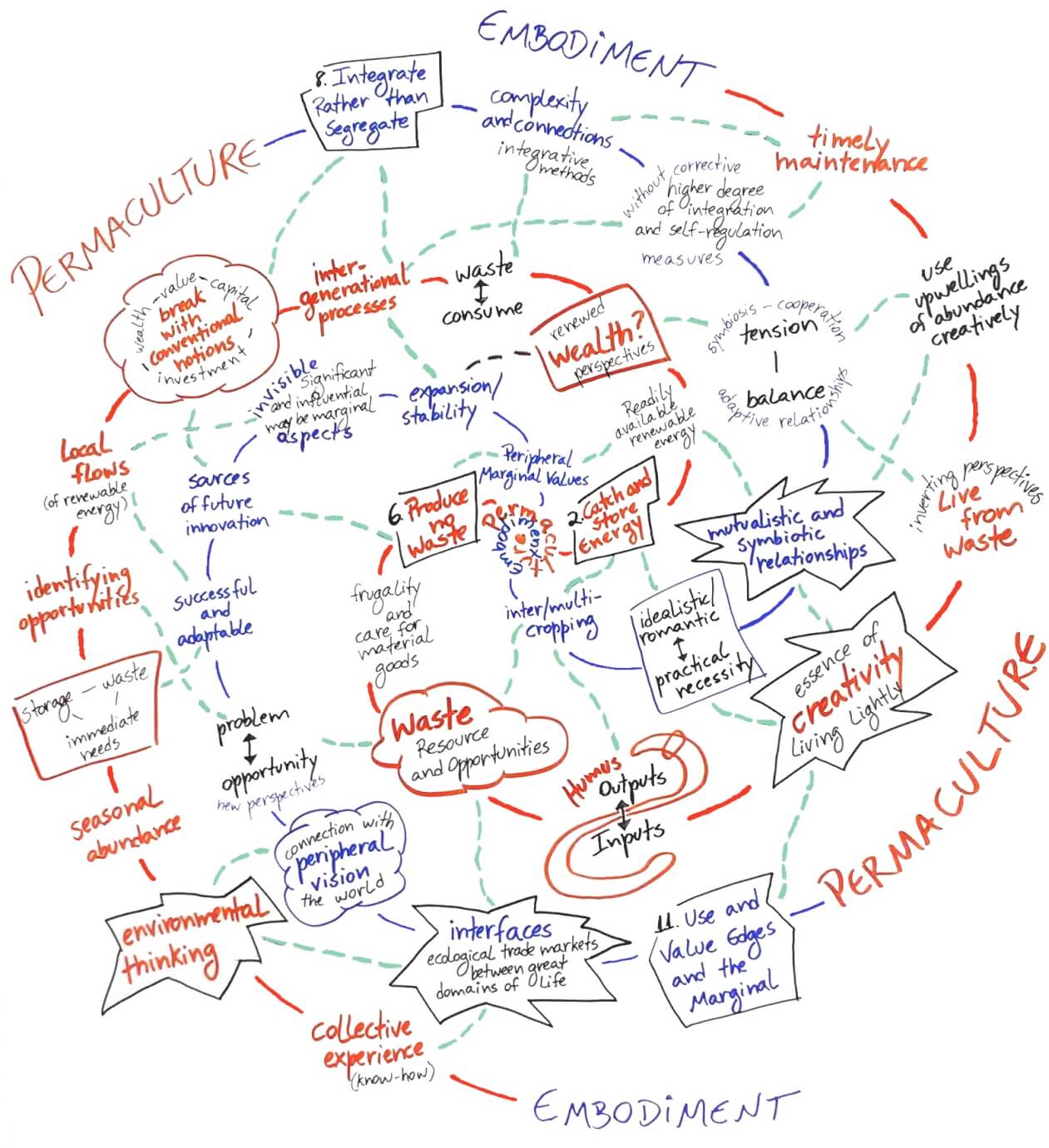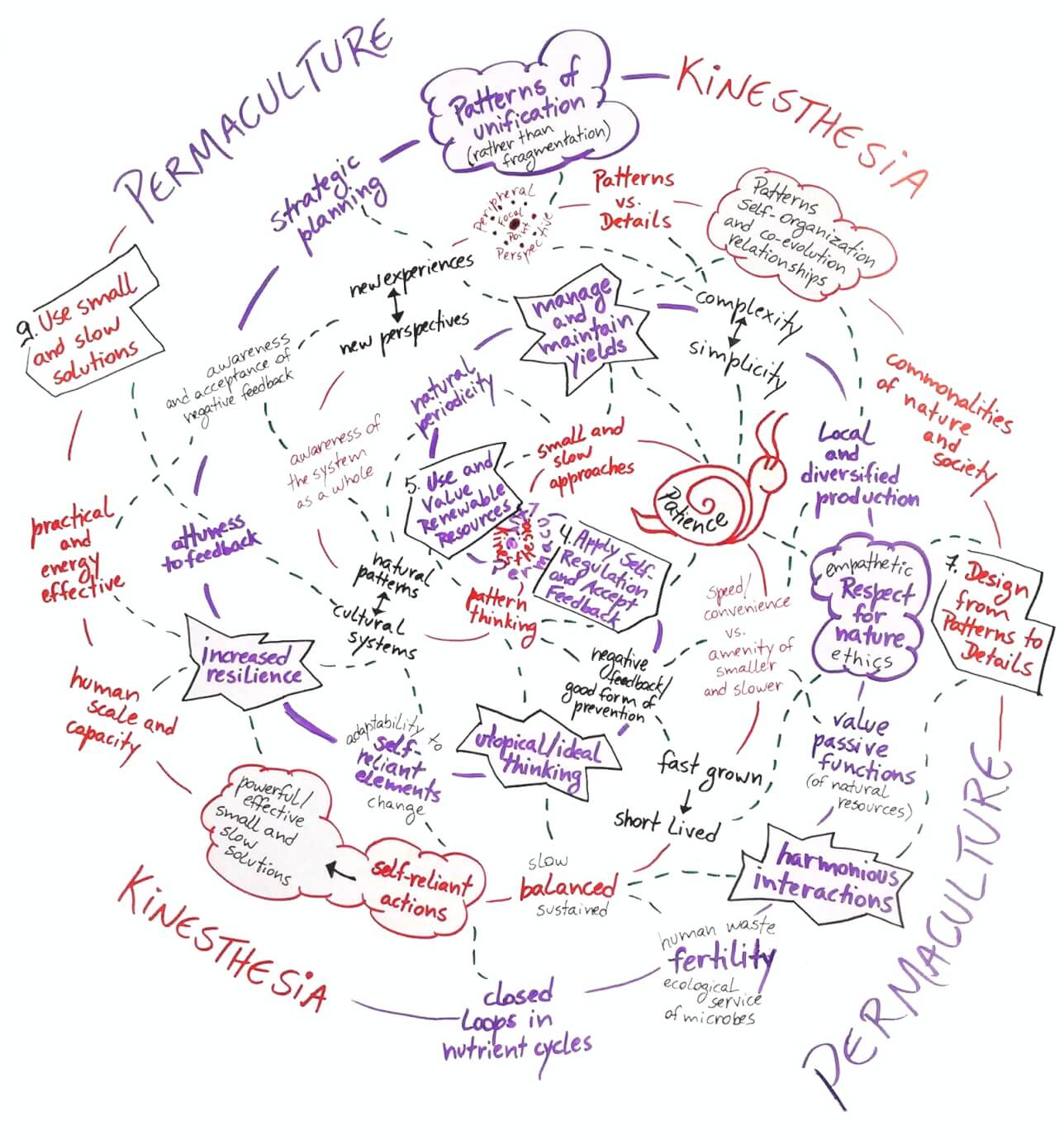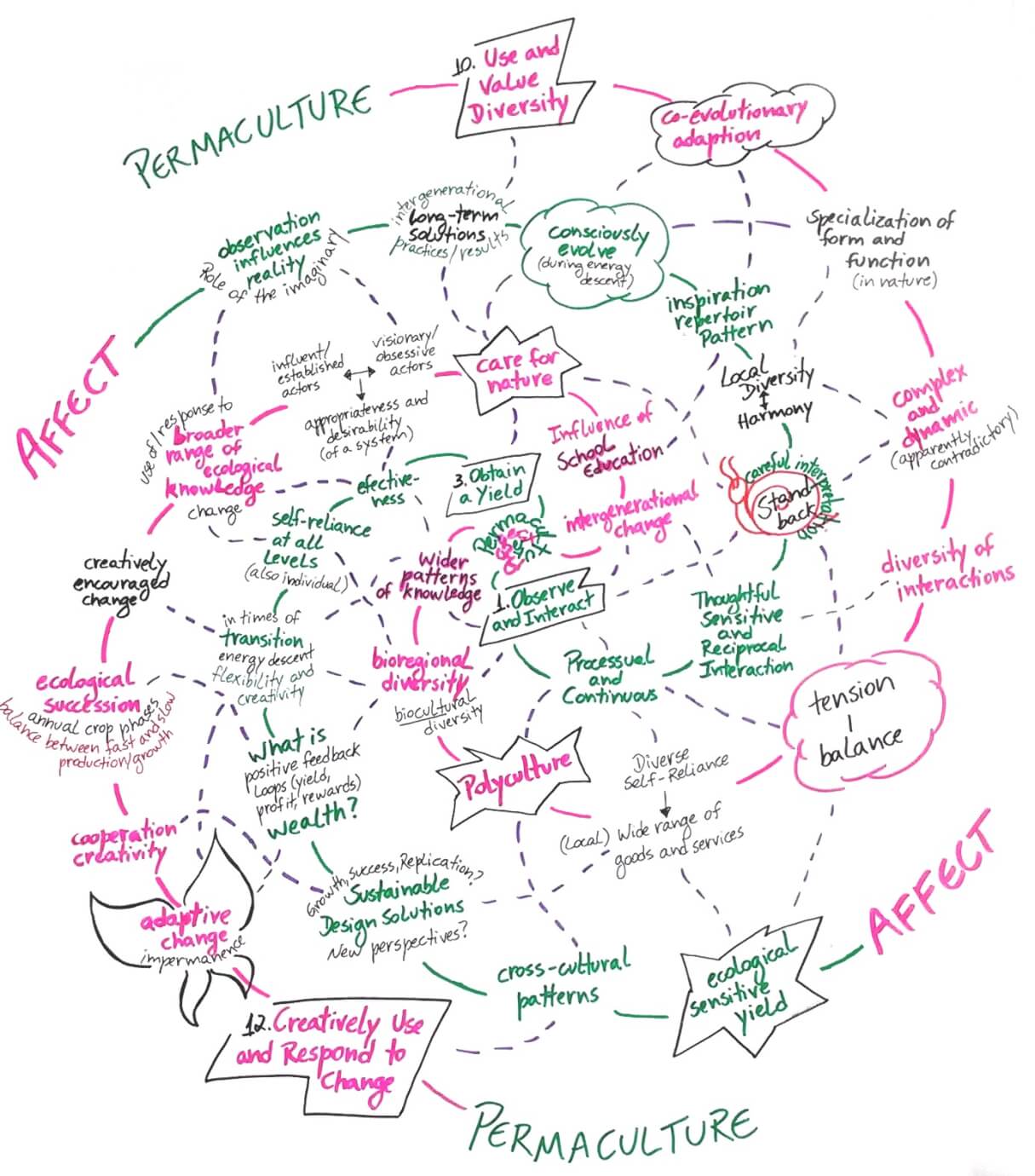A Poetic Reading of Permaculture in Three Helical Aesthetic Plans
Permaculture is an emergent agricultural design system based on principles of ethics of the human co-existence with nature. The term derives from the definition of permanent agriculture and it was first coined in the 1970s by the Australian scholars Bill Mollison and David Holmgren. Its definition was soon amplified by the authors in order to incorporate the comprehension of permanent culture as an interdependent process of the design of agricultural systems. Beyond co-existing with nature, human beings are argued to be an integrant part of it, in a system of interdependence which affects both and which can be perceived in patterns of spiral and organic processes of relation. In face of current, not completely new, but definitely undeniable states of emergency of environmental catastrophes, climate change, and the abuse of non-renewable natural resources, investigations about emergent models for the human interaction with nature, such as permaculture, become crucial for ethical reconsiderations of human behaviour in moments of such emergency. Furthermore, not only is the emergent characteristic of permaculture as a possible innovative agri-cultural system worth investigating, but also — and, in this case, more importantly — the unconventional aesthetic paths that emerge from it are incredibly fruitful for reflecting upon such states of emergency.
The pragmatic steps usually found in the books and guides for permaculture are based on deep philosophical structures developed by Holmgren and Mollison that reflect the reciprocal interdependence between human and nature. The three main ethical principles of permaculture are: Care for Earth, Care for People, and Fair Share; which are followed by twelve, more pragmatic principles of its application: 1. Observe and Interact, 2. Catch and Store Energy, 3. Obtain a Yield, 4. Apply Self-Regulation and Accept Feedback, 5. Use and Value Renewable Resources and Services, 6. Produce no Waste, 7. Design from Patterns to Details, 8. Integrate Rather than Segregate, 9. Use Small and Slow Solutions, 10. Use and Value Diversity, 11. Use Edges and Value the Marginal, and 12. Creatively Use and Respond to Change. These pragmatic principles are divided in two sets of perspectives, one of a bottom-up (1–6) and the other of a top-down (7–12) approach to the possible forms of integrating permaculture on an individual, local, and communitarian as well as on larger national and international scales. Despite this division of bottom-up and top-down approaches, all the principles can be adapted to several individual or broader forms of application and throughout the descriptions of each principle it is also possible to encounter many similarities or central knots that resemble one another.
The approaches put forward through the philosophy of permaculture enlighten a current growing and necessary move towards the entanglement of theory, or philosophical and ethical concerns, with practice. Furthermore, its principles also emphasize an important epistemological issue of embracing unconventional forms of knowledge-production and sharing. In several of the principles, it is possible to find analogies to the observation and appreciation of local conditions, such as the already existing potential of local environments and local knowledge, in order to propitiate and improve beneficial connections among all the elements of specific ecosystems. Surely, there are also several critical points in the models and philosophy of permaculture, such as the focus on a very anthropocentric perspective of ecosystems, the search for a universalization of its models, and the sometimes slightly utopic approaches. However, it is not my intention in this contribution to develop a critical review of the term. Instead, the aesthetic substance intrinsic in its principles is explored also as an emergent characteristic of permaculture and the forms in which an aesthetic perspective may widen the comprehensions of the relationality between culture-nature are presented through a poetic reading of these principles.
The poetic reading of permaculture is performed in three plans of helical aesthetics, ‘organically drawn’, according to the main and recurrent aspects evident in its twelve pragmatic principles. The helical plans are reflected upon through three main (unconventional) aesthetic categories: embodiment, kinaesthesia, and affect. Aesthetic approaches to permaculture have usually been restricted to its association with superficial forms and the visual qualities of the design systems, or to the commodification of aesthetics through the analysis of the patterns and functionality that it evidences. However, aesthetics holds much wider and deeper potentialities when associated with the human relation to nature. The ‘unconventional’ affective, embodied, and kinaesthetic-aesthetic qualities are presented, therefore, in order to explore the comprehension of aesthetics as multisensorial perceptions and experiences of the world, as well as to indicate the integrative and meaningful potentialities of such comprehension of aesthetics.
Furthermore, there are several ambiguities present in the models of permaculture which are worthy of deeper and considerate thought. Such ambiguities comprise various dimensions of environmental perception, like for example: immediate interactions and results versus long-term planning; individual responsibilities and local planning versus the peripheral perspective and wider ranges of connections; or the universalization of patterns versus the specificities of local environments. These ambiguous relations proposed in models of permaculture can be taken as significant qualities when explored for their potentials of being or ‘not being’ — their potentials of always becoming. Such ambiguities could indicate possible “flaws” in the system. However, in this case, they are perceived as an open end that makes the systems of permaculture much more interesting to explore. The helical aesthetics brings forward such ambiguities in cyclical and spiral patterns of interaction, which are also recurrent in the permaculture models. Each helical plan was drawn holding four of the principles of permaculture, two defined as bottom-up and two as top-down principles. Nevertheless, there are recurrent elements in several of the principles and the three helical plans could be rearranged in varied forms of combinations. Considering also that there is a fundamental dynamic of rotation implicit in each helical plan, imagining their combined rotation (even in opposite directions), could bring to the fore the kind of entanglement that such a poetic reading tries to embrace. Besides the spiral pattern formed by each of the principles, there are interconnections among various knots in each helical plan which were drawn with a lighter and discontinuous line. This visual characteristic breaks with the evident spirality of the plans and brings a subtle aspect of chaos indispensable for the entanglement of these principles. Nonetheless, it does not break completely with the rhythmic and flowing possibilities of the helical aesthetics.

In the various facets of permaculture, the alternatives for developing ‘functional, though ecological’ systems can be closely related to the importance of developing a critical and conscious awareness of the body and its interaction with the environment. Such a mindful and embodied perception of space (and time) can be emphasized through a phenomenological comprehension of aesthetics as a multisensorial perception of the world. The comprehension of embodiment as going beyond an individual body and reaching peripheral spectrums of existence — in the form of a ‘field of flesh’ — enhances the understanding of important aspects of the relational quality of such interaction with the world. This form of embodied relation expands also beyond the material conditions (of a permaculture system) to its ephemeral and imaginary qualities. It is also important to realize that these forms of interaction are in constant change, but they are also recurrent. Therefore, it is possible to perceive specific patterns that are, nonetheless, not cognitively predetermined. Perceiving the human beings as immersed in the relational rhythms of ecosystems and the environment — not only as consumers, but also as potential producers of energy; or not only producing waste, but also being responsible for creatively consuming such waste — is a fundamental part of the process of comprehension of the embodied significance of perception.

The relationships formed through such rhythmically composed transitions among the ambiguities present in permaculture systems can also be interpreted through the kinaesthetic awareness. Movement, in this sense, is a fundamental aspect of the unity of the senses and the embodied experience of space and time. It is the direct contact, or the immediate sensorial experience of moving in space, that propitiates the comprehension of the world and the creation of meanings which are related to this sensorial experience. The helical aesthetics enhances the ambiguity of this relation to time. It is about the immediate moment, about the sensorial experience and awareness of living in the present. However, it goes beyond this sense of immediacy, and is moreover about extending this moment through the slower apprehension of it, which resembles the rhythmic equilibrium of life. The kinaesthetic sense evolves intrinsically to the constant flows between change and stability. However, the increasingly growing speed of daily life impoverishes this sensorial perception. The senses get numbed by the acceleration and overwhelming amount of visual and sensorial information made available in (or even imposed on) daily routines. This inorganic acceleration affects the sense of self-regulation and generates an impoverished perspective of beneficial patterns of (ecosystemic) behaviour. The impact of this sense of speed on social relationships performs, therefore, disruptive effects on the human-nature relations and the individual (or communitarian) body awareness and mindfulness. ‘Negative feedbacks’, as defined in permaculture systems, are then poorly recognized and several destructive behaviours, such as the overuse of non-renewable resources for example, are kept as constant practices in a damaged cycle of interactions.

Following these helical movements, another insightful poetic turnaround of the permacultural principles is bonded to the sense of connection and the relation to diversity. Ecosystemic connections are in constant flow of change and, therefore, valuing diversity and emergent subverting perspectives is a practice that needs to be cultivated. Such practices require a sensitive openness to the very processual flows of change inherent in the rhythms of ecosystems and one’s integration in it — it is necessary to reconsider established values and subvert them again and again, in order to widen the ranges of available knowledge. Affect, in this sense, connected to embodiment and kinaesthesia, enhances the emergency of such comprehension of the uninterrupted processes of becoming in a constant interaction and movement. The possibility of creatively responding to this constant process of change (or, perhaps not only respond to, but also be part of) revolve to developing a deep sense of self-awareness — allowing oneself to take the time to create the meaningful connections that are sought in this movement. In order to be open to diversity and perceive the emergent flows of varied forms of ecological knowledge, it is necessary to observe life closely and one’s own responses (in an individual sense, as well as in the sense of the ‘field of flesh’) and integration with it. Affect brings about the synesthetic characteristics of this participation in the processes of the becoming of the ecosystems, which are also crucial to the aesthetic perception and experience.
This brief investigation of the helical aesthetics in relation to the principles of permaculture indicates that the profound and emergent potentiality of aesthetics in these systems spreads widely beyond its initial association with the superficial forms of design. The values shared in the permaculture principles embrace important aspects of the embodied and rhythmic time-space perception that relate to the affective response to environmental awareness and appreciation. In this sense, the helical aesthetic plans presented in this contribution propitiate distinguished forms to enrich fundamental discussions about the ethical relationships of human beings among themselves and towards their surrounding environments and other forms of beings. The emergency, in this case, lies in recognizing that the definition of ethic approaches to specific (social and environmental) issues is (or should be) generated through practical experience. Thus, aesthetic approaches are indispensable in this process, for they evidence the intrinsic characteristics of the rhythms of life and the bodily connection to the world, which are only attainable through experience.
The short interpretations for the helical aesthetic plans provided here constitute only a brief introduction to such possibilities and are far from determining a unique or exhaustive form. After all, the intention with the text has not been to describe the helical plans, but only give an initial interpretation, proposing an open-ended format and the invitation for the visual appreciation of the plans and possible further interpretations and re-significations to be performed. Such a pragmatic process is characterized more by the search for communication and sharing instead of imposing a single possibility for the poetic reading of the helical aesthetic plans.
The ambiguity of the sensorial experiences is a fundamental component of the ethic negotiations that surround human relationships. It permits a higher degree of reflexivity and multiple processes of meaning-making to be taken into account in the discussions about alternative possibilities and sustainable lifestyles. The aesthetic experience propitiates moments in which the senses can be awakened and connected. In addition to that, the practice of sharing aesthetic and poetic readings enables communication and the exchange of distinguished perceptions of the world, which can have transforming impacts on ethical relationships and political behaviour.
_References
Berleant, Arnold. Sensibility and Sense: The Aesthetic Transformation of the Human World. Exeter: Imprint Academic, 2010.
Berleant, Arnold. The Aesthetics of Environment. Philadelphia: Temple University Press, 1992.
Dewey, John. Art as Experience. New York: Paragon Books, 1934.
Lorimer, Hayden. “Cultural Geography: The Busyness of Being ‘More-than-representational’.” Progress in Human Geography 29, 1 (2005): 83–94.
Massumi, Brian. “The Autonomy of Affect.” In Deleuze: A Critical Reader, edited by Paul Patton, 217–239. Oxford: Blackwell, 2004.
Merleau-Ponty, Maurice. The Visible and the Invisible. Evanston: Northwestern University Press, 1968.
Merleau-Ponty, Maurice. The Phenomenology of Perception. London: Routledge and Kegan Paul, 1962.
Mollison, Bill. Permaculture: A Designer’s Manual. Tasmania: Tagari Publications, 1988.
Mollison, Bill, and David Holmgren. Permaculture One: A Perennial Agriculture for Human Settlements. Melbourne: Transworld, 1978.
Thrift, Nigel. Non-Representational Theory: Space, Politics, Affect. London, New York: Routledge, 2008.
_How to cite
Andressa Schröder. “A Poetic Reading of Permaculture in Three Helical Aesthetic Plans.” On_Culture: The Open Journal for the Study of Culture 1 (2016). <http://geb.uni-giessen.de/geb/volltexte/2016/12061/>.



